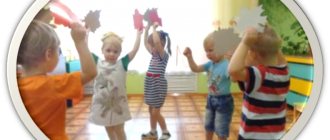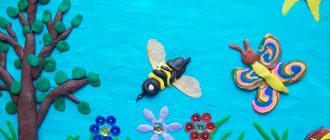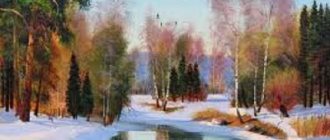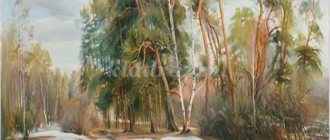Abstract “Spring has come to visit us” in an early age group
Summary of an integrated lesson in an early age group “Spring has come to visit us!”
Goal: To promote the development of children’s cognitive activity, enrich their ideas about spring (changes in nature), and activate vocabulary on the topic.
Educational areas: “Socio-communicative development”, “Cognitive development”, “Speech development”, “Physical development”.
Tasks:
1. Educational:
to form children’s ability for dialogical speech; learn to answer questions in words and sentences consisting of 3-4 words; enrich and activate vocabulary on the topic
2. Developmental:
teach to listen carefully and observe, when observing, to highlight the most striking, characteristic features of changes in nature
3. Educational:
cultivate a caring attitude towards the surrounding nature, trees, flowers.
(Children sit on chairs) Presenter: Guys, look how many guests have come to us, let's say hello to them. Hello! (Music sounds, spring enters) Spring: Hello, guys! Spring has come to visit you, I bring you my warmth, So that everything around you blooms, So that the leaves bloom, The birds sing. Guys, I want to invite you to visit me in the spring forest. Do you agree? Children: Yes Spring: But in order to go on a journey, we need to say the magic words. All the children gathered in a circle, you are my friend, and I am your friend, let’s hold hands tightly and smile at each other. Let's smile at each other, twirl, spin, and we find ourselves in the forest. Here we are in the forest. Why can't you see the sun today? Where did the sun hide? Let's look for him. Children: Behind the cloud. Spring: What color is the cloud? Children: Blue. Spring: How do we drive away the cloud? Children: Let's blow on it. (Breathing exercise) Spring: Let's blow on one shoulder, let's blow on the other, let's blow on the tummy like a tube in our mouth, let's blow on a cloud, let the cloud fly away. So our cloud flew away. What kind of sun has become now? Children: Cheerful, warm, radiant Spring: What color is the sun? Children: Yellow. Spring: Guys, do you know a poem about the sun? Tell the sun a poem. (Poem about the sun) Spring: Guys, the sun warmed the snow and it melted. A puddle has appeared, look what it is? (Pointing to the blue rag on the floor) Children: Puddle. Spring: What kind of puddle? Big or small? Children: Can I jump over it? Children: No. Spring: That's right, we'll walk through it on the pebbles, here they are. How many pebbles? Children: A lot Spring: We pass one after another, carefully. We don’t stand in a puddle, otherwise you might get your feet wet and get sick. Well done, crossed the puddle. And who else is hiding from us? Children: Bunny. Spring: Guys, the bunny is shaking all over, he was scared of us. Pet the bunny so that he calms down and stops being afraid of us. Tell me about the bunny, what kind of bunny? (Children pet the bunny and talk about him) Children: Gray, fluffy. Spring: What kind of bunny ears does it have? Long or short? Children: Long. Spring: What about the ponytail? Children: Short. Spring: Guys, look, the bunny has stopped shaking and wants to play with us.
P/i “The gray bunny is sitting”
Spring: Well done, how fun you played, let's let the bunny go. Guys, not all the snow in the forest has melted yet, there is still a large snowdrift. Oh, who's moving there? Let's see who it is? Children: Bear. Spring: Oh, I slept for a long time. The bear is bored, let's play with him?
P/i "Bear"
Spring: Well done! We cheered up the bear, let him sit and look at us. Look what we have growing here? Children: Trees. Spring: What is this on the trees? Children: Leaves. Spring: What color are the leaves? Children: Green. Spring: In spring, the sun shines brighter and warmer, and this causes green leaves to appear on the trees. Spring: Guys, it’s late, it’s time for you and me to return to kindergarten. Over the hummocks, over the stumps, be careful not to fall, jump - jump, jump - jump! We turned around, turned around, and returned home to our own kindergarten. Well, guys, did you like our trip to the spring forest? Children: Yes. Spring: Who did you meet in the forest? (Children's answers) Spring: Guys, you walked with me and played with me. I have prepared gifts for you. Bright, multi-colored balls. What color are the balls? (Children's answers) But it's time to say goodbye, and for me to return to the forest.
Lesson summary “Spring is Red” (nursery group)
Nellya Kozlovtseva
Lesson summary “Spring is Red” (nursery group)
Subject:
"Spring"
Target:
promote the development of children's cognitive activity, enrich their ideas about spring natural phenomena, and enhance speech development.
Tasks:
Educational:
to form in children an idea of seasonal changes in nature: it has become warm, the sun is shining brightly, buds are swelling on the trees, leaves, grass, and the first flowers are appearing; Learn to perceive the image of spring through artistic and musical expression.
Developmental: develop coherent speech, attention to observing spring phenomena; develop the ability to imitate a given image, develop imagination, creativity and fine motor skills.
Educational: to cultivate the ability to see the beauty of nature, to cultivate interest and curiosity for nature; to cultivate the sound culture of speech: correctly pronounce the vowel sound [u], correctly pronounce onomatopoeia -kap - kap;
Integration of educational areas:
cognitive development, social and communicative development, physical development, speech development, artistic and aesthetic development.
Leading educational area:
cognitive development
Form of activity:
joint activities of adults and children.
Leisure participants:
children of the first younger group (2-3 years old, teacher and junior teacher.
Materials and equipment: image of a steam locomotive, model of a “cloud” and “sun”; carousel hoop; clothespins, flowers mockup, basket.
Preliminary work:
• Conversations, examination of illustrations: “Spring”, “Signs of Spring”.
• Games: “Dress the Katya doll for a walk,” “What’s extra?”
• Experimental research activities: implementation of the “Droplet” project (studying the properties of water, snow, ice).
• Learning finger gymnastics, “Radiant Sun” exercises.
• Compiling a descriptive story based on the painting “Spring” (from the “Seasons” series). Observing changes in nature.
Expected results:
He can guess the season based on a verbal description, name the signs of spring, answer questions on the topic, and select objects for their intended purpose.
Progress of the lesson:
Introductory part.
(A teacher in a Spring costume comes out to the group and addresses the children)
Educator: Hello, guys! Do you know what time of year it is? (Spring).
That's right, spring, spring-red - that's me. I'm so glad you recognized me. For a long time I walked to you through winter blizzards, cold winds and snowdrifts. Let's talk about the time of year - spring! Tell me, does the snow melt in the spring? Are there puddles? Are the buds swelling? Are the birds flying? In spring, the first flowers and grass appear? Is it raining and the sun is shining brightly? Guys, let's call Sunny?
(Call "Sun")
The sun is clear, dress up, (claps on the shoulders, cross your arms over your chest)
Red sun, show yourself (clap your hands)
Put on the scarlet dress, (clap your knees)
Give us a red day. (clapping overhead)
(The sun sets)
Sun:
Hello guys! I am very glad to meet you. You called me so loudly that I could not help but come to you.
Main part.
Educator:
Guys, look at our Sunshine? Warm, light, round? Do you know what the sun is for? It warms everything on the earth, helps flowers, trees and children grow. Our spring sun is gentle, because spring has come. Let's play with the sun?
(Game “Solar Carousel”)
Educator:
Ray up, ray down,
Smile at the children as a ray of rays,
Look to the right, to the left,
Go around the sun.
(Children take hold of the ray ribbons and move in a circle to the song. At the end of the song they stop)
Educator:
Did you like the game? Let's make a sunshine together?
(Construction from clothespins “Sun”)
(Children pinch clothespins along the edge of the model of the sun (cloud))
Educator:
Then we’ll make a cloud.
Educator: Oh, we didn’t even have time to make a cloud when it started to rain!
(Physical school)
Rain, rain, little by little,
Drip and drip onto your palm. (tapping your finger on your palm)
I'm jumping through puddles
And now our boots (we put the boots on our feet and start walking through the “puddles”)
We put it on the legs.
Educator:
Tap your fingers on the table as if droplets are falling to the ground. Now it’s raining heavily and our droplets are knocking hard and fast. Now the rain has begun to weaken, we knock quietly, rarely. When the last drop has fallen, tap it once with your finger. The sun has shone again and is calling us into the forest. The first flowers grew in the forest. Let's go, admire them and collect them in a basket, and then bring them to the kindergarten.
Educator: Oh, what are we going to drive? Maybe on a steam locomotive? Look, we have it (Shows a model of a steam locomotive).
Go!
Educator:
Guys, how is the locomotive humming?
(oo-oo-oo)
Let's all sound like a steam locomotive together: ooh-ooh.
Educator:
Here is our train coming,
The wheels are knocking
And on our train
The guys are sitting
Chu-chu-chu, chu-chu-chu!
(The locomotive approaches a clearing with flowers)
Educator:
Guys, admire the first spring flowers. How beautiful they are! Green grass will soon appear, and the first leaves will appear on the trees. The birds are singing loudly. This is what a beautiful spring is!
Educator: Look how many flowers there are! Oh, look there’s a basket. Let's collect flowers in a basket.
(Children collect flowers in a basket)
Final part.
Educator: What great fellows you all are! Our journey has now ended. It's time to go back. We all get on the locomotive and go back.
Sunny: Well, it’s time for me to return to my place too. Goodbye friends!
Calendar planning on the topic: “Spring” in the second early age group
Elena Matveeva
Calendar planning on the topic: “Spring” in the second early age group
Monday
Morning: Morning exercises.
Situational conversation “What are birds for”
.Goal: to expand children’s knowledge about what benefits birds bring to humans?
(birds destroy harmful insects, birds delight people with their singing)
Exercise “Release the bird.” [Development of fine motor skills. ]
Invite the children to cover the picture with their palm so that each finger covers the drawn bird. Did. game "Flies or Flies"
.Goal: to develop attention, speed of reaction to the word.
P. /game “Birds in nests”
.Goal: to develop a reaction to the word.
Placement in a group of paintings depicting different birds. Purpose: To expand the understanding of the birds that fly in our village.
Create a desire to help them. Develop observation skills. Educational activities
Walk: Bird watching. Give children general concepts about birds (pigeon, crow, sparrow)
Goal: learn to recognize them by appearance.
Artistic word: A bird flies over the field chirp-chik-chik...
Labor: feeding birds. Individual. work in jumps with forward movement - Did. ex. "Let's jump like sparrows"
.Goal: learn to jump on two legs.
P/i “Sparrows and a car”
- running in different directions.
Purpose: to exercise running, spatial orientation, agility.
Independent play activity of children with external material. Purpose: To teach how to find activities based on interests, to play together, to cultivate friendliness and tolerance.
Returning from a walk, KGN, lunch, work before bed Continue teaching children to carry out simple instructions: put napkins on the table, lay out spoons. Goal: To teach how to carry out instructions responsibly.
Evening: will improve your health. and hardened. procedures, CGN, afternoon snack, games, self. children's activities, leisure,
Gymnastics after sleep “Walk”
.
aesthetic game “Little Birds” to music Goal: To develop the ability to move to music, accompanying the movements with words from the game. Did. game “What kind of bird is this?”
.Goal: to learn to correctly name objects and their actions.
Game situation “The dolls have woken up and are getting dressed”
Goal: To develop the ability to choose a role, to perform several interrelated tasks with toys
actions. Offer children pictures to look at: “The rooks have arrived”
,
“Feeding birds”
. Goal: to expand knowledge about birds.
Walk. Outdoor game: “Airplanes”
.Goal: to develop speed and attention
Tuesday
Morning: Conversation with children Spring has come to us ”
.Goal: To promote the development of speech as a means of communication.
Develop understanding of speech and activate vocabulary. “Whose house?”
Goal: To teach children to recognize wild animals and name their homes. Enrich your vocabulary, learn to pronounce words correctly and clearly. "Finger game " Spring ""
,
“Drops”
,:
“Sun”
. Purpose: Development of fine motor skills of the hands and speech apparatus.
Listening to musical works on the topic “Spring Awakenings”
. Goal: To develop interest in music, the desire to listen to music, sing along, and perform simple dance movements.
Games, preparing for a walk
Walk: Tell the children that in spring the sun heats up more, the snow and ice melt.
Goal: to clarify and consolidate children’s knowledge about spring , signs of spring , the sequence of their onset. Expand and clarify children's knowledge about natural phenomena. "Jumping"
.Goal: To teach children to perform standing jumps, correctly take the starting position, perform a jump, and maintain balance.
P.I: “Horses”
. Goals: exercise walking while maintaining balance; develop speed, agility, coordination of movements.
Independent play activity of children with external material. Purpose: To teach oneself to find activities of interest, to play together, to cultivate friendliness and tolerance.
Returning from a walk, KGN, lunch, work before bed Continue teaching the skills of neatly folding clothes on their chairs. Reading Bianca's "The Foundling"
.
Evening: will improve your health. and hardened. procedures, CGN, afternoon snack, games, self. children's activities, leisure,
Gymnastics after sleep. Role-playing game "Hospital"
.Goal: To develop the ability to show interest in the gaming activities of peers.
Learning the nursery rhyme “The sun is a bucket.”
Purpose: To teach storytelling
nursery rhyme expressively. Develop memory, learn to accompany speech with appropriate movements. D.I. “Find a place”
.Goal: To teach children to pay attention to the relative position of objects. Develop attention and visual memory.
Adding poplar branches to the group (consider small buds)
.
In spring they begin to swell. Buds are houses for leaves. They slept in their houses all winter, but the sun began to warm up.
Walk. "Owl"
.Goals: exercise in fast running, climbing; develop self-control and organization in collective activities.
Wednesday
Morning: Complex of morning exercises “ Spring is ”
.Situational conversations: How to recognize
Spring ? Why do they say “nature has woken up”
? Purpose: to teach answering questions;
develop thinking and dialogical speech. Exercise “Obedient Buttons.”
Purpose: To develop self-service skills, teach children to fasten large buttons, and help each other.
Develop fine motor skills of the hands. Didactic game “Find the right color”
.
Goal: To teach children to apply knowledge about colors and act according to oral instructions.
Develop attention.
Working with the nature calendar . Goal: Continue to acquaint children with the characteristic features of the seasons, teach them to name the seasons. Learn to find on calendar and mark the current time of year.
Games, preparing for a walk
Walk "Who is faster?"
,
“Stream”
.Goal: to teach how to run freely without bumping into each other, to respond to a signal by returning to their place.
Development of movements. Goal: to practice walking with an extended step. Sonya, Yaroslav, Vika A.P.I.: “Migration of birds.”
Goals: to train children in running; learn to move from one action to another; develop dexterity and the ability to navigate in space. Independent play activity
children with takeaway material. Goal: To teach them to find activities based on their interests, to play together, to cultivate friendliness and tolerance.
Returning from a walk, KGN, lunch, work before bed Continue teaching the skills of neatly folding clothes on their chairs. Reading From Vangeli "Snowdrops"
.
Evening: will improve your health. and hardened. procedures, CGN, afternoon snack, games, self. children's activities, leisure,
Gymnastics after sleep
Work in the music education corner: musical and didactic game “Guess what I’m playing”
.goal: To develop children's timbre hearing, to teach them to distinguish the sound of familiar noise instruments, to name them correctly. Creative workshop: drawing with sticks
“Spring Sun”
. .goal: To teach children to apply round and straight color spots on a sheet of paper with cotton swabs. Reading: A. Barto
“The Dirty Girl”
goal: To introduce children to poetry, to teach them to understand the content of the work. Arouse the desire to be neat, teach to compare oneself with the image created by the poet. Place pictures in a corner of nature depicting observed objects and phenomena in April; Cultivate emotional responsiveness to natural phenomena.
Walk. P.I. “Shaggy Dog”
.Goal: To teach children to clearly pronounce the text and perform movements in accordance with the words. Enrich motor experience.
Thursday
Morning: Complex of morning exercises Situational conversation “What do we wear in spring ”
.goal: continue to introduce children to items of clothing, shoes, hats, recognize them in pictures;
D.I. “What’s more?”
Objectives: To teach children to understand the essence of the task, to compare objects in size with a sample, to indicate the result of comparison with the words
“less”
,
“more”
.
P.I. “Catch a mosquito
.
goal: To teach children to jump in place, pushing off vigorously with both legs. Develop the ability to concentrate and develop attention Did. game "Assemble a pyramid"
.Objectives: Teach children to select rings by size and color.
Develop attention, develop the ability to compare, compare.
Games, preparing for a walk
Walk: P.I.: “Shaggy Dog”
.Goal: to exercise running on a signal, spatial orientation, agility.
“Catch deer.”
Goals: practice running, catching players
(deer)
; learn to act quickly on a signal and navigate in space. Development of movements. Goal: to consolidate the ability to navigate the kindergarten area, find an object according to the description. Observing the melting of snow. Walking around the area with children, note where the snow and ice are melting faster - in the sun or in the shade, why?
Labor: Putting order in the area. Goals: to teach children to keep the area clean. Independent play activity of children with external material. Goal: To teach how to find activities of interest, to play together, to cultivate friendliness and tolerance.
Returning from a walk, KGN, lunch, work before bed Continue teaching the skills of neatly folding clothes on their chairs. Reading L. Tolstoy “The Bird Made a Nest...”
.
Evening: Gymnastics after sleep Game situation “Walk in the spring forest”
.goal: To promote the development of role-playing games based on the impressions received while viewing the paintings.
"What is this?"
.goal: To teach children to understand the essence of the task, recognize and name familiar objects.
Game situation “Good will not go away, but evil will disappear
.
goal: To encourage manifestations of compassion in children, a desire to help, and to form a friendly attitude towards each other. Submitting an album for viewing: “ Spring has come again ”
.Goal: To expand understanding of the characteristic signs
of early spring .
Walk. P.I. “Birds in the nests”
.Objectives: Teach children to run with a change in tempo of movement, to act on a signal. Increase motor activity, enrich motor experience.
Friday
Morning: Complex of morning exercises “ Spring is ”
.
Teacher's story "Kapel"
.Goal: To develop children's powers of observation, curiosity, and to activate speech.
“Find the same one.”
Goal: Teach children to look for objects with given properties, determine the location of an object using various landmarks. Work in a corner of nature: observation
“Watering flowers.”
Goal: Continue to familiarize children with the labor operations of caring for indoor plants.
Remind children of the names of plants. Exhibition of books with a spring theme; P.I. “The Hen and the Chicks.”
Goal: To teach children how to perform play actions correctly. Develop independence and creativity when performing exercises.
Games, preparing for a walk
Walk: P.I: “Catch a mosquito”
— To develop in children the ability to coordinate movements with a visual signal, to train children in jumping
(bouncing on the spot)
.
“Guess who’s screaming”
- To develop children’s observation, attention, and movement development. Goal: to consolidate skills in jumping from a height of 10 cm.
Stas, Arina, Alina. Observation: wind, clouds, clouds. Reading: A. Pushkin “Wind, wind, you are mighty.”
goal: To expand children’s understanding of natural phenomena, to introduce them to the characteristics of the wind, independent play activities for children with external materials. goal: To teach them to find activities based on their interests, to play together, to cultivate friendliness and tolerance.
Returning from a walk, KGN, lunch, work before bed Continue teaching the skills of neatly folding clothes on their chairs. Reading L. Tolstoy “ Spring has come... ”
.Goal: To consolidate knowledge of the names of the seasons, to continue to introduce the main signs
of spring.
Evening: Gymnastics after sleep. Riddles on spring themes.
Goal: development of logical thinking. “What should we wear for a walk?”
goal: To teach children to correctly name items of clothing, to use adjectives in speech - definitions, P.I. “The hen and the chickens”
.goal: To teach children to perform play actions
(climb under the rope, moving sideways, without touching the ground with their hands)
.
Offer children coloring pages on the theme “Spring changes in nature.”
Purpose: To maintain interest in visual arts. Develop fine motor skills of fingers.
Walk. P. And “Wind and Clouds”
Goal: To teach children to move consistently in a given direction, to respond to
the teacher’s verbal signals .





